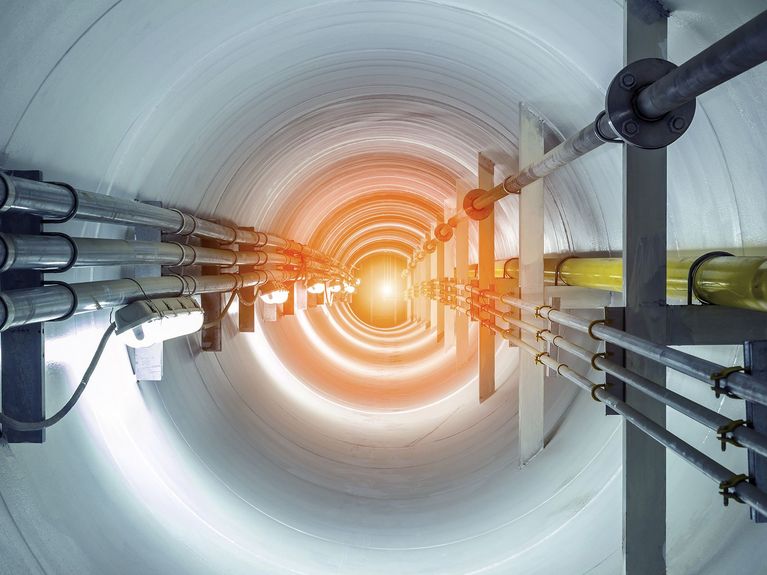Superconductivity
New research approach explains ‘unconventional’ superconductivity

A superconductor that also works at normal temperatures could have broader applications, such as for inner-city power cables. Image: DifferR/Shutterstock
Superconductors carry electricity without resistance. They could be used in power cables, wind turbines or electric motors, but to do so they would have to be cooled well below freezing. Now, experiments with the superconductor strontium ruthanate have provided new insights that could lead to more widespread use of superconductors more quickly.
Research is driven by curiosity. Curiosity can uncover unknown relationships that can lead to new insights and applications. Jörg Schmalian of the Karlsruhe Institute of Technology (KIT) and his research colleagues are always open to new discoveries, and they recently found something that could bring the promising field of superconductors into widespread use more quickly. Superconductors are technically very interesting because they conduct electricity without any electrical resistance. However, they must be cooled to temperatures well below freezing. As a result, they have been used only in niche applications, such as in MRI machines or as memory elements in quantum computers.
Jörg Schmalian is head of the Institute for Condensed Matter Theory (TKM) at the Karlsruhe Institute of Technology (KIT). Image: KIT
A superconductor that also works at normal temperatures could be used more widely, for example, for inner-city power cables, smaller and lighter wind turbines, or electric motors for airplanes. For this to happen, physicists would have to understand the microscopic mechanism of superconductors better. This is known for conventional superconductors, but they have to be cooled to a few degrees above absolute zero (-273 °C). So-called high-temperature superconductors require less cooling: They conduct electricity at temperatures as low as -135°C. How this is achieved is still unknown. However, it is hoped that once high-temperature superconductivity is understood, it will be possible to synthesize a superconductor that works even at normal temperatures.
High-temperature superconductors belong to the class of so-called unconventional superconductors. Jörg Schmalian’s team is researching this type of material. But what happens in superconductivity? In a superconducting state, electrons overcome their mutual repulsion and form pairs. They merge into a collective quantum state. This state extends throughout the solid: Current flows without resistance. In conventional superconductors, electrons interact with vibrations in the crystal lattice to overcome their repulsion. In unconventional superconductors, the electrons manage to coalesce by interacting with each other. The only question is how they do it.
The graph shows how the transition temperature, below which the superconducting state occurs, increases in strontium ruthanate. (Graphic: Y.-S. Li, et al. Nature 607, 276 (2022))
“Strontium ruthanate is an ideal model system for studying unconventional superconductors,” says Schmalian. The physics of the metal in its normal conducting state is very well understood, so it should be easier to decipher the superconducting state. “We experts just thought it was a shame that we didn't understand superconductivity in strontium ruthanate,” explains the theoretical physicist.
To satisfy their curiosity, Schmalian’s team is pursuing a new approach together with experimental physicists at the Max Planck Institute for Chemical Physics of Solids (MPI CPfS) in Dresden. “Electrons are always thought of as being confined in a rigid lattice of atoms,” explains Schmalian. “However, we assume that the cage can be elastically deformed,” says the physicist.
“Our partners in Dresden can do this in a very controlled and precise way by applying mechanical pressure to the material,” explains Schmalian. In the case of strontium ruthanate, this tripled the transition temperature to superconductivity from about 1 to 4 degrees above absolute zero. And something amazing happened: The material became dramatically softer, making it much easier to deform.
Schmalian’s team was able to describe the softening effect mathematically. The pressure changes the atomic lattice in which the electrons exist, so their behavior changes as well. This is partly because there are more quantum mechanical states that the electrons can assume at these low temperatures. They become more free, so to speak. This in turn affects the chemical bonds between the lattice atoms meaning the material becomes softer.
There are other subtle effects on the physics of the electrons, which surprisingly all work in the same direction, adding up to a significant softening of the material by 30 percent. The effect, which is more than a thousand times larger than originally expected, is contributed to by less than one percent of the electrons in the solid, the research team found.
“These results also help us understand superconductivity in strontium ruthanate,” Schmalian explains. Everything suggests that the electrons overcome their mutual repulsion by exchanging magnetic fluctuations. The Karlsruhe team is currently working on the theory.
This success would not have been possible without the intensive cooperation between theoretical and experimental physicists at the Max Planck Institute, which takes place within the framework of the Transregional Collaborative Research Center Elasto-Q-Mat, emphasizes Schmalian.
“I am convinced that this knowledge will also enable us to better understand high-temperature superconductivity,” says the physicist. There may be no upper limit to the temperature of superconductivity in unconventional superconductors, he explains. This is because the electrons can achieve their mutual attraction even without lattice vibrations. The research in this area could therefore lead to superconductors that change everyday life.
To the original publication: https://www.science.org/doi/10.1126/science.adf3348
Readers comments